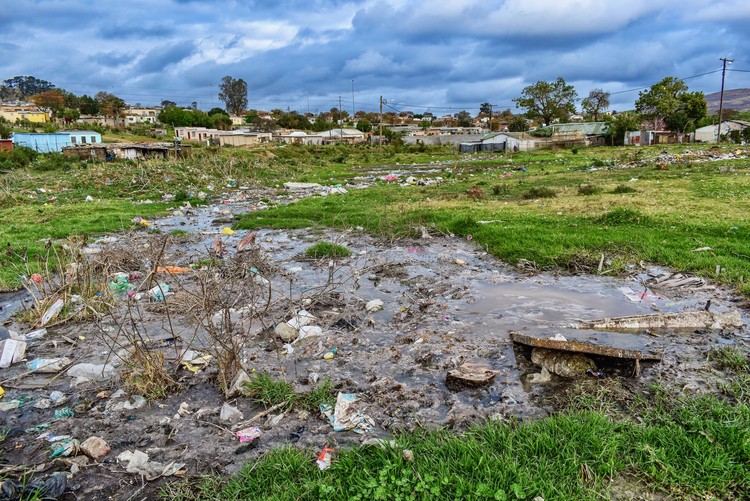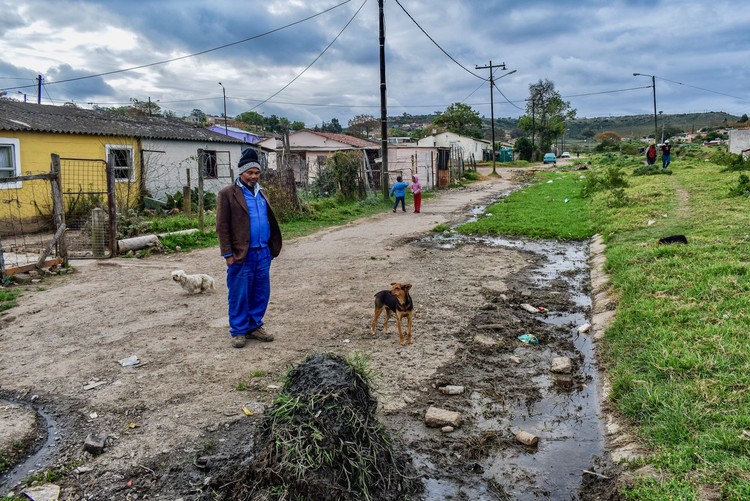Makhanda households fed up with living in a sewage nightmare
Residents of Hooggenoeg and Scotts Farm say the sewer system has been dysfunctional for over a decade
Overflowing drains have created marshes of sewage in Scotts Farm, Makhanda. Photos: Lucas Nowicki
- Dozens of households in Hooggenoeg and Scotts Farm, Makhanda, live with the perpetual stench of overflowing drains and a permanent sewage marsh.
- An engineer says the failure of multiple basic services, including “water-shedding”, has compounded the issue.
- The municipality says sewage flows are normal and blames residents for putting “foreign materials” in the system.
What should be a relatively attractive area to live in, up on the Makhanda hill, has become a never-ending nightmare for residents of Hooggenoeg and Scotts Farm. Besides Makhanda’s severe water shortages and the country’s rolling blackouts, the residents have been forced to deal with the ever present stench of overflowing and backed-up sewage for a decade now. The poor sewage management is also partly to blame for the many potholes and poor road condition in the area.
Sewage from blocked drains regularly floods homes in Hooggenoeg. These sewage leaks accumulate into streams of sewage that run from the hills of Hooggenoeg down into the neighbourhood located below.
Residents say many of the leaks are left for months, sometimes more, before municipal workers respond. One leak below first avenue in Hooggenoeg is said to be 20 years old, creating a marsh of sewage that runs down to Scotts Farm.
Hooggenoeg was home to 225 households, and Scotts Farm to 282 in the 2011 census. Both areas were designated coloured areas under apartheid. Most of the houses are now old and dilapidated. It is a poor area with high unemployment.
Sidney Olifant with the stream of sewage ebbing from a marsh caused by overflowing drains in Scott’s Farm, Makhanda.
Sidney Olifant lives next to a stream of sewage ebbing from a marsh of sewage caused by overflowing drains in Scott’s Farm. It has eroded the dirt road in front of his house. When it rains, the sewage spreads into his home.
“In summer the smell gets so bad, and there are also lots of mosquitoes,” he says.
We found Olifant desperately digging channels to try and divert the sewage. He says a bulldozer is needed to clear the marsh.
When municipal workers are called, they “just look at it and say they will come back but never do”, he says.
Olifant has lived here since 1986. He is unemployed.
Charmaine Marthinus lives with a sewage marsh in front of her house in Scott’s Farm. She told GroundUp that she is dreading the summer, as the stink becomes impossible to escape. Sometimes the municipality comes in summer to put “white powder” (probably lime) over the sewage, but this does not ease the smell.
Anele Mjekula, Makana’s municipal spokesperson, however, insisted the flow in the municipality’s bulk sewage infrastructure is “normal”. He said municipal workers often “find foreign materials”, such as cloth and stones, in the system and this causes blockages. Mjekula said “an awareness campaign” to “strengthen communication regarding these issues” was being planned by the municipality.
He said the municipal workers prioritise bulk infrastructure issues before focussing on individual households.
Mjekula said that Makana gets a lot of calls from Hooggenoeg, and that they are “aware that there are delays” in responding to reported leaks – “which we need to improve”.
Berend Walters, a longtime Hooggenoeg resident and community activist, has taken to unblocking drains himself to help people in the area.
Berend Walters, a longtime Hooggenoeg resident and community activist, says blaming residents for the sewage leaks is “nonsense” and it is the municipality’s responsibility to maintain the infrastructure.
Walters said that a couple of years ago when a new pipeline was laid they thought their sewage problem would be solved. But it was a botched job, he says.
It was meant to take effluent from Extension 10 through Hooggenoeg to Belmont Valley Waste Water Treatment Works, which the municipality says is budgeted for an upgrade in the 2023/24 financial year.
This bulk infrastructure upgrade project was to address the additional burden of the large number of households that Extension 10 had added to the Makhanda system. The project was “fine” the municipality told GroundUp.
A visit to the area suggests otherwise.
After years of trying to get the municipality to respond to the blocked drains and sewage leaks, Walters, who works part time renovating houses in the area, started clearing out the drains himself with the help of some other residents and metal rods.
We met Walters after he had unblocked a drain near a house that was going to host a funeral the next day.
The issue of sewage leaks and drain blockages in Makhanda is linked to a variety of poor service delivery issues, according to Peter Sturrock, a retired civil engineer with a history of working on such infrastructure projects.
“If there is no refuse collection, people are more likely to flush foreign objects down the toilet, and if there is no water, as the name implies, water-borne sewerage systems will not work and get blocked,” Sturrock told GroundUp.
Makhanda is experiencing an ongoing water crisis, and to deal with the shortage of water the municipality often employs water-shedding, which sees the water switched on every second day (recently water has been on for longer periods.)
Sturrock says the lack of water to help sewage flow through the drains can lead to blockages.
Refuse collection, especially in the poorer areas of Makhanda, is unreliable. In 2020, a group of residents had to take the municipality to court for failing to regularly collect rubbish, provide refuse bags and clean up illegal dumpsites.
Makhanda relies on two sewage treatment works, the Belmont Valley and the smaller Mayfield Waste-Water Treatment Works. When GroundUp visited the Mayfield Sewage Works with Sturrock and Walters, it was not operational.
A steady stream of sewage was running next to the fences surrounding it. The two workers present told us that around a year ago power cables were stolen from the site, and that they have not had electricity to operate it since.
Sturrock says that much of the sewage destined for these waste-water treatment works ends up running into local rivers, such as the Kowie, which flows into the sea at Port Alfred.
Support independent journalism
Donate using Payfast

Don't miss out on the latest news
We respect your privacy, and promise we won't spam you.
Next: Home Affairs taken to court over blocked IDs
Previous: GroundUp reporters win prestigious journalism award
© 2023 GroundUp. This article is licensed under a Creative Commons Attribution-NoDerivatives 4.0 International License.
You may republish this article, so long as you credit the authors and GroundUp, and do not change the text. Please include a link back to the original article.
We put an invisible pixel in the article so that we can count traffic to republishers. All analytics tools are solely on our servers. We do not give our logs to any third party. Logs are deleted after two weeks. We do not use any IP address identifying information except to count regional traffic. We are solely interested in counting hits, not tracking users. If you republish, please do not delete the invisible pixel.




